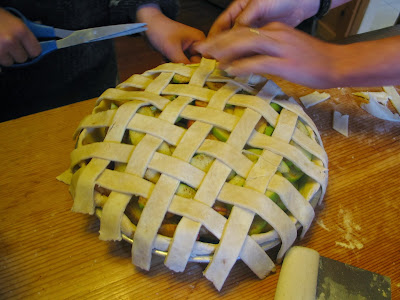(given to us by members of our community in exchange for apple pie):
-Washington
State has more glaciers than the other 47 contiguous states combined. (Linda)
-Equatorial
Guinea is the only country in Africa to have Spanish as its official language
(Hunter)
-The
Mariana Trench is
the deepest spot in the ocean, 35,760 feet below sea level (Nate)
-“Home
on Range” is the official state song of Kansas (Eva)
-
Azkaban (the prison in Harry Potter) is named for a small lake in Russia
(Abbey)
-Crater
Lake is the deepest lake in the United State. At one point it was a 14,000+ foot mountain,
which imploded into itself (Lisa)
-The
reason they know that the earth’s magnetic poles flip is that they’re able to
look at minerals within an ocean trench to see evidence of the change (Andrew
L)
-In
the 1800s the New Madrid fault line caused an earthquake in the Midwest that
was felt in New York (Andrew L)
-The
Red River in Minnesota flows North. You
can travel from Minnesota to Hudson Bay on it. (Andrew K)
-Northeast
Iowa is called the “driftless” region because the glaciers scraped the rest of
Iowa flat but missed the driftless region leaving it forested and rolling
(Peter)
-Harney
Peak in South Dakota is 7,244 feet—it is the highest peak in the U.S east of
the Rockies (Dale)
-There’s
a town in Quebec, Canada called La Tuque named after a hill that looks like a
Tuque (James)
-The
first place you can see the sunrise in the United States is on the top of Cadillac
Mountain on Mount Desert Island in Arcadia National Park (Andy)
-In
Northern Minnesota there’s a lake called Cass Lake—it has an island called Star
island—it’s the only freshwater lake with an island with a freshwater lake
inside of it (Claire)
-Vatican
City is the smallest country (Sharon)
-48
of Montana’s 52 counties are considered frontier counties, which means that
there are less than 6 people per square mile (Tressa)
-In
1888 Helena, Montana had more millionaires per capita than anywhere else in
the U.S. (Tressa)
-The
lowest point on land you can stand on is the beach of the Dead Sea—it’s about
1,500 feet below sea level (David)
-A
device for remembering coastal countries in Africa from Egypt, around the west
coast of the country, ending with Equatorial Guinea: Every Lotto Ticket a moron wins my sister guzzles great glasses of
slurpy leaving ice globs tightly bonded near the crystal’s edge. (Rosa)
-If
you drained Lake Chelan it would cover Washington at a depth of 4 inches
(Chris)
-In
North Central Mauritania, there’s something called a Richat structure that’s 31
miles in diameter—it’s a symmetrical uplift made by erosion that you can see from space (Lisa)
-In
Papua New Guinea there are over 800 languages and dialects (Janine)
-The
Northernmost point of the continental United States is in Minnesota. However you can’t get there by car—you either
have to boat or by way of Canada (Ellen)
-The
two cities I lived in before coming here were on the Mississippi River (Ellen)
-The
hottest temp ever to be recorded in the world is believed to be 134 degrees F
in Furnace Creek Ranch, CA recorded on 10/7/1913 (Bonnie)
-The
shortest river in North America is the Chelan River (Rosa)
-It’s
550 miles to hike from Oregon to Canada on the PCT (Natalie)
-If
you drilled a hole through the middle of the world straight through (from where
we are now) you would end up in the Indian Ocean, right off the coast of
Madagascar (Cindy)












































